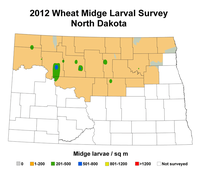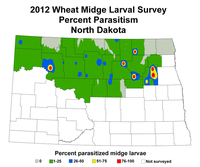Wheat Midge Levels Drop to Record Lows for 2013
(Click an image below to view a high-resolution image that can be downloaded)
Soil samples in North Dakota indicate low levels of overwintering wheat midge larvae (cocoons) for the 2013 season, according to Janet Knodel, North Dakota State University Extension Service entomologist.
“With the majority of soil samples statewide being low risk for wheat midge infestation, insecticides should not be needed for controlling wheat midge in 2013,” she says. “However, we still recommend field scouting for wheat midge even with low populations to ensure that wheat midge will not reduce wheat yields, grade and quality.”
A total of 199 soil samples were collected from 21 counties to estimate the regional risk for wheat midge. The distribution of wheat midge in the 2013 forecast map is based on unparasitized cocoons found in the soil samples collected in the fall of 2012.
""The southeastern area of Mountrail County and southeastern area of Ward County are the only two pockets of moderate risk that need to be monitored closely for wheat midge,"" Knodel says.
Wheat midge populations ranged from zero to 786 midge larvae per square meter, with an average of 34 larvae per square meter in 2012. In contrast, wheat midge populations ranged from zero to 1,879 midge larvae per square meter, with an average of 171 larvae per square meter in 2011.
“The decrease in wheat midge can be attributed to the drought, which may have prevented wheat midge larvae from dropping out of the wheat heads in late summer,” Knodel says. “Moisture (rain or dew) triggers mature larvae to drop to the soil surface, where they burrow in and form overwintering cocoons. If larvae did drop out of the head, they encountered hard, dry soils, which may have prevented them from moving down into the soil and exposing them to predators. This would decrease the overall number of overwintering wheat midge cocoons as indicated by the results of the wheat midge soil survey.”
There were no areas where the cocoon populations exceeded 1,200 per square meter, which would have indicated they were at high risk for a wheat midge infestation in 2013. Areas of moderate risk (populations of 501 to 1,200 midge larvae per square meter) accounted for only 1 percent of the samples. These areas were in southeastern Mountrail County and southeastern Ward County. Field monitoring is recommended for areas at moderate risk.
In most of the remaining counties, 27 percent of the samples had one to 500 larvae per square meter (low risk) and 72 percent had zero larvae per square meter.
“Although these areas with one to 500 midge larvae per square meter are considered low risk, it is always good practice to scout fields to determine if an action threshold population level exists, especially if weather conditions favor wheat midge emergence and development,” Knodel says.
Weather conditions prior to and during adult wheat midge emergence will play an important role in determining the amount of economic damage. Conditions that favor midge development and outbreaks include high soil moisture in late June, warm temperatures, calm winds and high humidity during egg laying in early July.
A degree day model is a good predictor of wheat midge emergence and can help time field scouting. It is available on the NDSU North Dakota Agricultural Weather Network website at http://ndawn.ndsu.nodak.edu/wheat-midgedd-form.html.
Field scouting is conducted at night when temperatures are greater than 59 degrees F and the winds are calm (less than 6 mph) during the heading to early flowering crop stages.
""With the high market value of hard red spring wheat, the economic threshold for durum is used for both spring wheat and durum, which is one midge per seven to eight durum heads,” Knodel says. The critical time to spray is from late heading to early flowering. If wheat scab is a problem due to wet conditions during flowering, most insecticides labeled for wheat midge control can be tank-mixed with a fungicide.
The parasitic wasp Macroglenes penetrans plays an important role in keeping wheat midge controlled naturally most years by killing the wheat midge larvae. However, the average parasitism rate significantly decreased to 7 percent in 2012, compared with 19 percent in 2011 and 17 percent in 2010.
Parasitism ranged from zero to 100 percent across the state, with the higher rates occurring in areas where midge populations have been high the past few years. Eighty-five percent of the larval cocoons in 2012 had zero parasitism. The dramatic decrease in parasitism could cause wheat midge populations to increase in future years if environmental conditions become more favorable for wheat midge development.
“We need to continue to conserve parasitic wasp populations when possible by spraying insecticides only when wheat midge populations are at economic threshold levels, and avoiding any late insecticide applications to minimize the negative impacts on the parasitic wasps that are active at that time,"" Knodel says.
The soil samples were collected by NDSU Extension Service agents in the fall of 2012.
The wheat midge survey is supported by the North Dakota Wheat Commission.
NDSU Agriculture Communication – Jan. 21, 2013
| Source: | Janet Knodel, (701) 231-7915, janet.knodel@ndsu.edu |
|---|---|
| Editor: | Rich Mattern, (701) 231-6136, richard.mattern@ndsu.edu |



